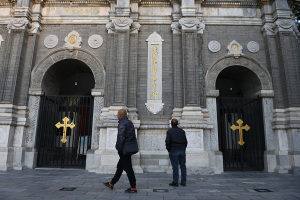East Vs West Coast Earthquakes: Differences in Culture
Residents of the East coast are far less accustomed to the rumbling and shaking caused by earthquakes than those who live along the Western Seaboard.
After the 5.8 magnitude temblor that struck the East Tuesday, California experienced two quakes at 3.6 and 4.4 magnitudes, within 12 hours of one another. The differences between the earthquake incidents go much deeper than just location and magnitude.
The Associated Press released a special report Tuesday highlighting the extreme differences of quakes that occur along each coast. The report stated that the East Coast consists of older land mass, and has stiffer rocks, making earthquakes highly unusual there. Because of this, the infrastructure of the region is not designed to endure quakes.
The residents of the region are unfamiliar with being so “rattled,” and most of those who felt Tuesday’s quake had never felt one before.
In response to the East’s reaction to Tuesday’s earthquake, Twitter user Andrew said, “wow, east coast earthquakes have a much more effective public relations strategy than west coast quakes.”
The media hype was a natural reaction for Easterners. In addition to the Eastern Seaboard being so unacquainted with temblors, experts cannot identify where the fault ruptured, adding to the fear and uncertainty of the event.
The geological make-up of the East Coast also makes it very difficult for scientists to predict when quakes will occur, and residents in New York and many other Eastern cities were completely aghast by the quaver.
In New York, office buildings were evacuated as a cautionary measure, as were buildings in D.C., including the White House and Pentagon. The quake rocked the East Coast just weeks before the 10th anniversary of September 11, and many people were relieved to learn that the shaking was merely an act of nature.
Tuesday’s temblor was felt along over 1,000 miles of the East Coast, an area 10 times the size of earthquake’s rattles felt in the West.
Different from the East, Geologists in California can easily assume that quakes happen along the San Andreas fault, as Earth’s giant floating plates shift, collide, or slip past one another. Quakes are also common in Oregon, Alaska, and Washington, and happen at least once a year, normally with ample warning.
Since 1900, West Coast states have experienced 103 earthquakes with magnitudes over 5.8, where as the East Coast has only experienced two.
West-Coasters poked fun at the East for their reactions to the earthquake that was felt from Georgia to Maine on Tuesday, prompting a Twitter feud.
“Dear East Coast quake survivors welcome to our world… Love, The West Coast,” said a Twitter user.
“Text ‘Sorry you spilled your chai latte’ to 90999 to donate $1 to the victims of the U.S. East Coast earthquake,” joked another West Coast resident on Twitter Tuesday.
In retaliation, East Coast resident and Twitter user Dexter wrote, “Get back to us when a dusting of snow doesn’t cause widespread panic. Love, the East Coast.”
“If the East Coast starts having more earthquakes, it’d only be fairplay that the West Coast starts getting some serious hurricane action,” Brian said in reply to West Coast jeers.




























